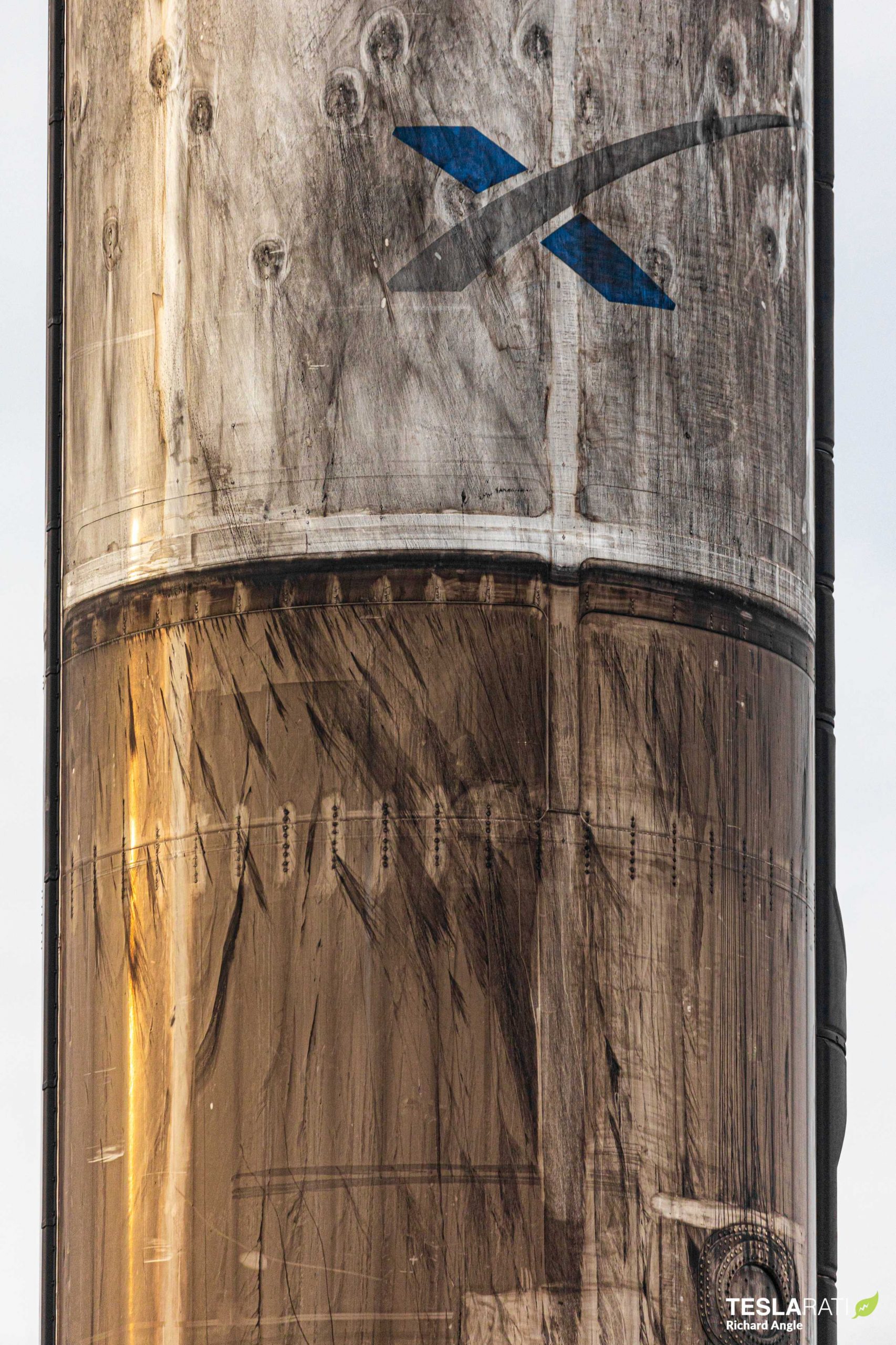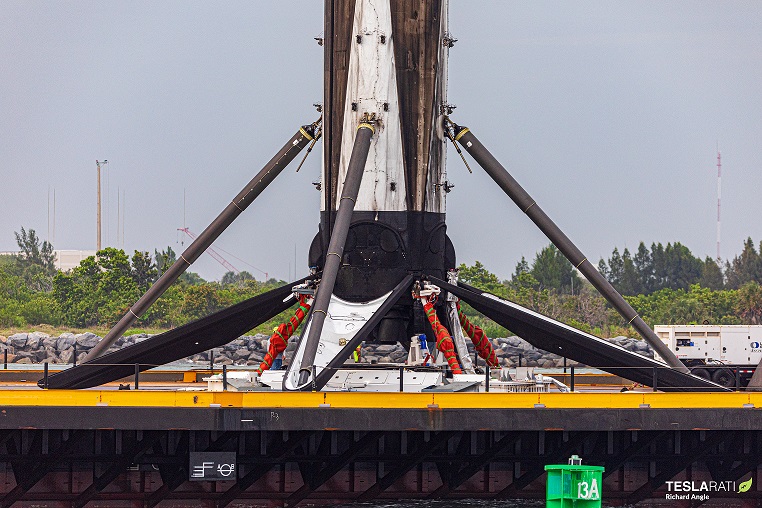
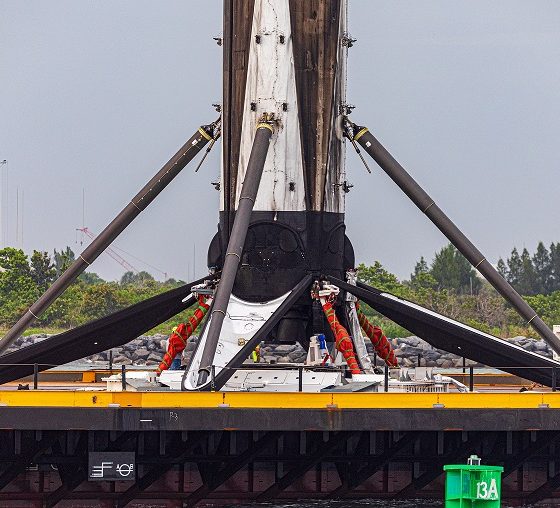
News
SpaceX record-setting booster returns to Port in remarkable condition (photos)
SpaceX has successfully recovered its second Falcon 9 in less than a week. Just four days after it launched, booster B1049 returned to sailed into Port Canaveral. The veteran booster is the first to launch and successfully land five times. On June 3, at 9:25 p.m. EDT (0125 GMT on June 4), B1049 took to the skies, delivering another batch of Starlink satellites into orbit.
Now, just three days after a flawless mission, the veteran rocket sailed triumphantly into port. Perched atop SpaceX’s newly remodeled drone ship, Just Read the Instructions (JRTI), B1049’s exterior was visibly more charred after its most recent trip through the atmosphere. This successful landing marks the first mission that JRTI was active in the Atlantic Ocean, as well as the third successful sea recovery in a row for SpaceX.
So far this year, SpaceX has successfully launched nine boosters this year. All but two of them have been recovered—two failed to land on the drone ship. One of those botched attempts was due to some residual cleaning agents trapped inside the engine. That booster, B1048, was SpaceX’s only other booster (so far) to fly five times.
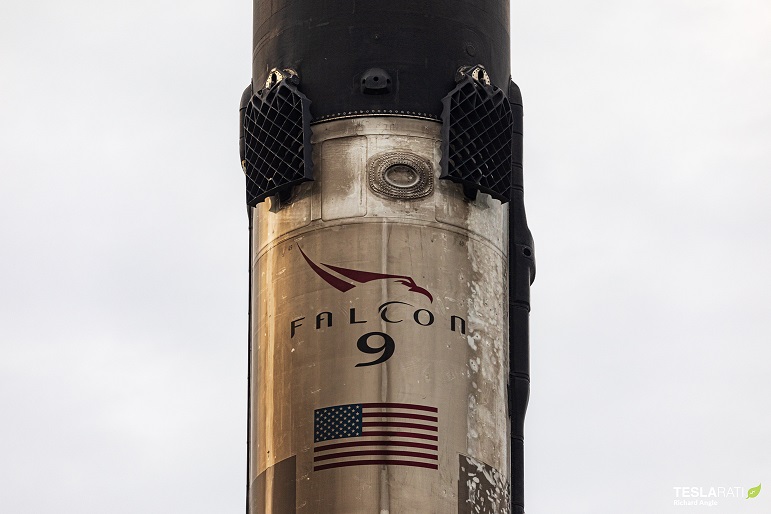
But it surely won’t be the last. B1051 has already completed four successful missions and could see flight again soon. SpaceX has at least two other launches planned for June, including another Starlink launch and the launch of a GPS satellite for the Air Force. That flight will be on a new booster, B1060, per the Air Force’s request.
As it stands now, government payloads require SpaceX to use a new booster, versus a previously flown one. That was also the case for NASA’s commercial crew program. On May 30, astronauts Bob Behnken and Doug Hurley flew to the International Space Station atop a Falcon 9 rocket. The booster, which returned to Port just a few days ago, what a shiny new booster. However, in a recent development, NASA amended the agreement, saying that SpaceX could use previously flown boosters as well as reuse its Crew Dragon spacecraft.
Currently, SpaceX reuses its cargo version of Dragon, but each upgraded cargo (and Crew) variant can be reused as many as five times. Each booster is currently rated for ten flights, with minimal refurbishments in between.
Flying for the 5th time, the #SpaceX #Falcon9 launches from SLC-40 to bring another batch of #Starlink sats to orbit! The first stage was also recovered, marking the first time a booster has landed after 5 flights! pic.twitter.com/KcsNecEoI3
— Richard Angle (@RDAnglePhoto) June 4, 2020
SpaceX’s fleet of veteran rockets has dwindled a bit, with the loss of B1048 and B1056. Those losses came on the heels of two planned expenditures: B1046 and B1047. B1046was purposefully detonated as part of the company’s In-flight Abort test that occurred in January. That test was a lead up to the Demo-2 mission and proved that SpaceX’s launch escape system worked while B1047 carried the AMOS-17 satellite into orbit and was expended after depositing the satellite into space.
However, the California-based rocket builder should have some new Falcons rolling off the assembly line this summer, which will help support its ambitious Starlink launch manifest. This year, SpaceX has launched six Starlink missions, with at least one more planned for June, possibly two.
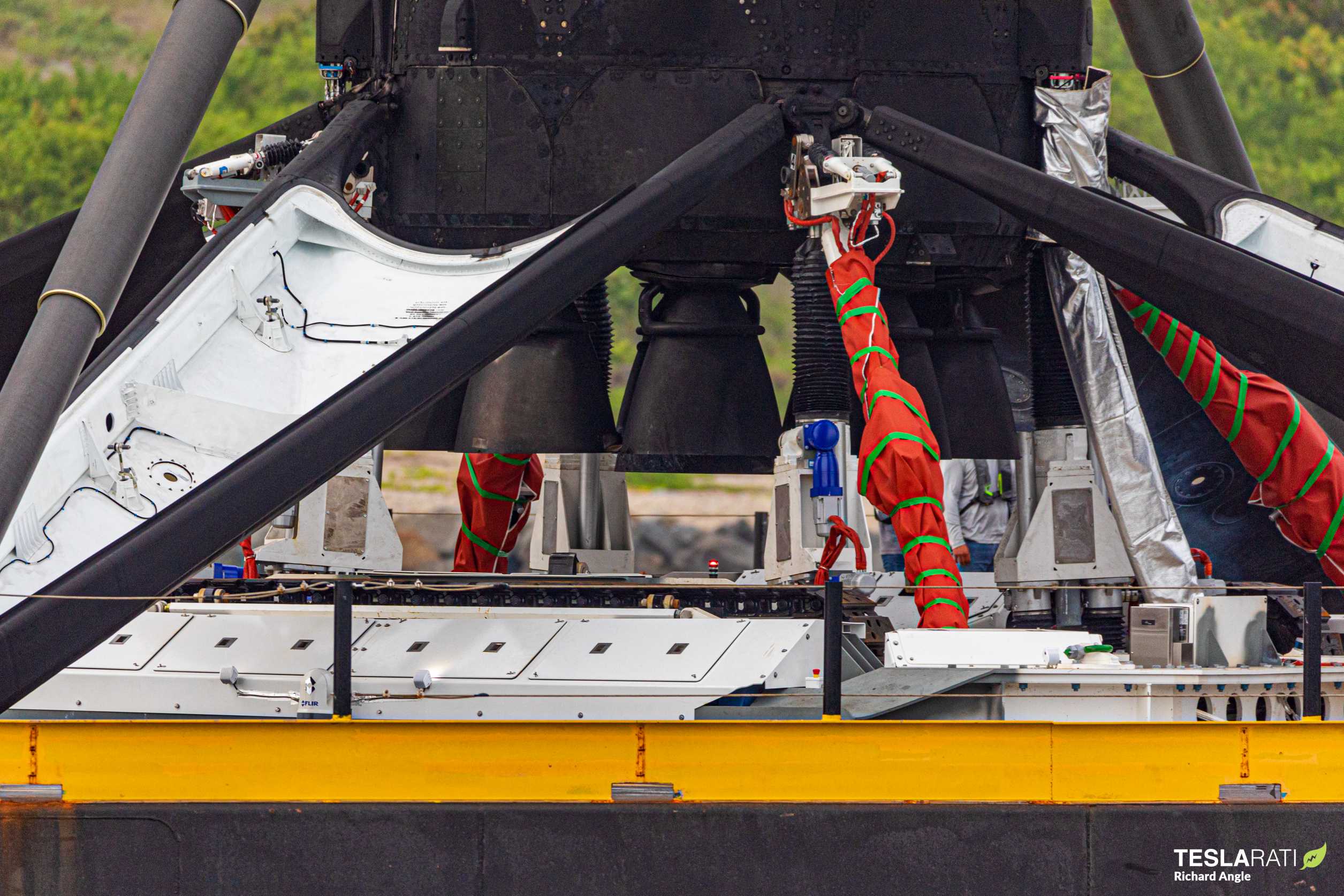
To date, SpaceX has launched a total of 482 Starlink satellites, but the company needs between 400-800 satellites on orbit to begin rolling out minimal coverage. To provide the coverage it wants, SpaceX is going to have to keep up the launch pace. And to do so, it will test the reusability factor of its rockets.
So far, we’ve seen two rockets fly five times, but when will B1049 fly a sixth time? How soon will we see a booster reach the 10-flight mark? What sort of refurbishments will it need then? With many more Starlink flights on deck, it will be interesting to see which boosters fly on which missions.

News
Tesla FSD fleet is nearing 7 billion total miles, including 2.5 billion city miles
As can be seen on Tesla’s official FSD webpage, vehicles equipped with the system have now navigated over 6.99 billion miles.

Tesla’s Full Self-Driving (Supervised) fleet is closing in on almost 7 billion total miles driven, as per data posted by the company on its official FSD webpage.
These figures hint at the massive scale of data fueling Tesla’s rapid FSD improvements, which have been quite notable as of late.
FSD mileage milestones
As can be seen on Tesla’s official FSD webpage, vehicles equipped with the system have now navigated over 6.99 billion miles. Tesla owner and avid FSD tester Whole Mars Catalog also shared a screenshot indicating that from the nearly 7 billion miles traveled by the FSD fleet, more than 2.5 billion miles were driven inside cities.
City miles are particularly valuable for complex urban scenarios like unprotected turns, pedestrian interactions, and traffic lights. This is also the difference-maker for FSD, as only complex solutions, such as Waymo’s self-driving taxis, operate similarly on inner-city streets. And even then, incidents such as the San Francisco blackouts have proven challenging for sensor-rich vehicles like Waymos.
Tesla’s data edge
Tesla has a number of advantages in the autonomous vehicle sector, one of which is the size of its fleet and the number of vehicles training FSD on real-world roads. Tesla’s nearly 7 billion FSD miles then allow the company to roll out updates that make its vehicles behave like they are being driven by experienced drivers, even if they are operating on their own.
So notable are Tesla’s improvements to FSD that NVIDIA Director of Robotics Jim Fan, after experiencing FSD v14, noted that the system is the first AI that passes what he described as a “Physical Turing Test.”
“Despite knowing exactly how robot learning works, I still find it magical watching the steering wheel turn by itself. First it feels surreal, next it becomes routine. Then, like the smartphone, taking it away actively hurts. This is how humanity gets rewired and glued to god-like technologies,” Fan wrote in a post on X.
News
Tesla starts showing how FSD will change lives in Europe
Local officials tested the system on narrow country roads and were impressed by FSD’s smooth, human-like driving, with some calling the service a game-changer for everyday life in areas that are far from urban centers.

Tesla has launched Europe’s first public shuttle service using Full Self-Driving (Supervised) in the rural Eifelkreis Bitburg-Prüm region of Germany, demonstrating how the technology can restore independence and mobility for people who struggle with limited transport options.
Local officials tested the system on narrow country roads and were impressed by FSD’s smooth, human-like driving, with some calling the service a game-changer for everyday life in areas that are far from urban centers.
Officials see real impact on rural residents
Arzfeld Mayor Johannes Kuhl and District Administrator Andreas Kruppert personally tested the Tesla shuttle service. This allowed them to see just how well FSD navigated winding lanes and rural roads confidently. Kruppert said, “Autonomous driving sounds like science fiction to many, but we simply see here that it works totally well in rural regions too.” Kuhl, for his part, also noted that FSD “feels like a very experienced driver.”
The pilot complements the area’s “Citizen Bus” program, which provides on-demand rides for elderly residents who can no longer drive themselves. Tesla Europe shared a video of a demonstration of the service, highlighting how FSD gives people their freedom back, even in places where public transport is not as prevalent.
What the Ministry for Economic Affairs and Transport says
Rhineland-Palatinate’s Minister Daniela Schmitt supported the project, praising the collaboration that made this “first of its kind in Europe” possible. As per the ministry, the rural rollout for the service shows FSD’s potential beyond major cities, and it delivers tangible benefits like grocery runs, doctor visits, and social connections for isolated residents.
“Reliable and flexible mobility is especially vital in rural areas. With the launch of a shuttle service using self-driving vehicles (FSD supervised) by Tesla in the Eifelkreis Bitburg-Prüm, an innovative pilot project is now getting underway that complements local community bus services. It is the first project of its kind in Europe.
“The result is a real gain for rural mobility: greater accessibility, more flexibility and tangible benefits for everyday life. A strong signal for innovation, cooperation and future-oriented mobility beyond urban centers,” the ministry wrote in a LinkedIn post.
News
Tesla China quietly posts Robotaxi-related job listing
Tesla China is currently seeking a Low Voltage Electrical Engineer to work on circuit board design for the company’s autonomous vehicles.

Tesla has posted a new job listing in Shanghai explicitly tied to its Robotaxi program, fueling speculation that the company is preparing to launch its dedicated autonomous ride-hailing service in China.
As noted in the listing, Tesla China is currently seeking a Low Voltage Electrical Engineer to work on circuit board design for the company’s autonomous vehicles.
Robotaxi-specific role
The listing, which was shared on social media platform X by industry watcher @tslaming, suggested that Tesla China is looking to fill the role urgently. The job listing itself specifically mentions that the person hired for the role will be working on the Low Voltage Hardware team, which would design the circuit boards that would serve as the nervous system of the Robotaxi.
Key tasks for the role, as indicated in the job listing, include collaboration with PCB layout, firmware, mechanical, program management, and validation teams, among other responsibilities. The role is based in Shanghai.
China Robotaxi launch
China represents a massive potential market for robotaxis, with its dense urban centers and supportive policies in select cities. Tesla has limited permission to roll out FSD in the country, though despite this, its vehicles have been hailed as among the best in the market when it comes to autonomous features. So far, at least, it appears that China supports Tesla’s FSD and Robotaxi rollout.
This was hinted at in November, when Tesla brought the Cybercab to the 8th China International Import Expo (CIIE) in Shanghai, marking the first time that the autonomous two-seater was brought to the Asia-Pacific region. The vehicle, despite not having a release date in China, received a significant amount of interest among the event’s attendees.
